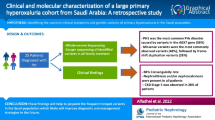Abstract
Primary hyperoxaluria type 1 (PH1) is a rare but devastating autosomal recessive inherited disease caused by mutations in gene AGXT. Pathogenic mutations of AGXT were mostly reported in Caucasian but infrequently in Asian, especially in Chinese. To update the genotypes of PH1 in the Chinese population, we collected and identified 7 Chinese probands with PH1 from 2013 to 2017 in our center, five of whom had delayed diagnosis and failed in kidney transplantation. Samples of peripheral blood DNA from the 7 patients and their family members were collected and sequencing analysis was performed to test the mutations of gene AGXT. Western blotting and enzyme activity analysis were conducted to evaluate the function of the mutations. Furthermore, a systematic review from 1998 to 2017 was performed to observe the genetic characteristics between Chinese and Caucasian. The results showed that a total of 12 mutations were identified in the 7 pedigrees. To the best of our knowledge, 2 novel variants of AGXT, p.Gly41Trp and p.Leu33Met, were first reported. Bioinformatics and functional analysis showed that only 7 mutations led to a reduced expression of alanine-glyoxylate amino transferase (AGT) at a protein level. The systematic review revealed significant population heterogeneity in PH1. In conclusion, new genetic subtypes and genetic characteristics of PH1 are updated in the Chinese population. Furthermore, a genotype-phenotype correlation is found in PH1.
Similar content being viewed by others
References
Hoppe B. An update on primary hyperoxaluria. Nat Rev Nephrol, 2012,8(8):467–475
Hopp K, Cogal AG, Bergstralh EJ, et al. Phenotypegenotype correlations and estimated carrier frequencies of primary hyperoxaluria. J Am Soc Nephrol, 2015,26(10):2559–2570
Cochat P, Rumsby G. Primary hyperoxaluria. N Engl J Med, 2013,369(7):649–658
Purdue PE, Lumb MJ, Fox M, et al. Characterization and chromosomal map** of a genomic clone encoding human alanine:glyoxylate aminotransferase. Genomics, 1991,10(1):34–42
Pelle A, Cuccurullo A, Mancini C, et al. Updated genetic testing of Italian patients referred with a clinical diagnosis of primary hyperoxaluria. J Nephrol, 2017,30(2):219–225
Toussaint C. Pyridoxine-responsive PH1: treatment. J Nephrol, 1998, 11(Suppl):49–50
van Woerden CS, Groothoff JW, Wijburg FA, et al. Clinical implications of mutation analysis in primary hyperoxaluria type 1. Kidney Int, 2004,66(2):746–752
Monico CG, Rossetti S, Olson JB, et al. Pyridoxine effect in type I primary hyperoxaluria is associated with the most common mutant allele. Kidney Int, 2005,67(5):1704–1709
Fargue S, Rumsby G, Danpure CJ. Multiple mechanisms of action of pyridoxine in primary hyperoxaluria type 1. Biochim Biophys Acta, 2013, 1832(10):1776–1783
Cochat P, Hulton SA, Acquaviva C, et al. Primary hyperoxaluria type 1: indications for screening and guidance for diagnosis and treatment. Nephrol Dial Transplant, 2012,27(5):1729–1736
Beck BB, Hoyer-Kuhn H, Gobel H, et al. Hyperoxaluria and systemic oxalosis: an update on current therapy and future directions. Expert Opin Investig Drugs, 2013,22(1):117–129
Hoppe B. Evidence of true genotype-phenotype correlation in primary hyperoxaluria type 1. Kidney Int, 2010,77(5):383–385
Wang F, Xu CQ, He Q, et al. Genome-wide association identifies a susceptibility locus for coronary artery disease in the Chinese Han population. Nat Genet, 2011,43(4):345–349
Michele Petrarulo SP, Marangella M, Cosseddu D, et al. High-performance liquid chromatographic microassay for L-alanine: glyoxylate aminotransferase activity in human liver. Clin Chim Acta, 1992, 208(3) 183–192
Barbara Cellini MB, Montioli R, Paiardini A, et al. Human wild-type alanine:glyoxylate aminotransferase and its naturally occurring G82E variant: functional properties and physiological implications. Biochem J, 2007,408(1):39–50
Williams E, Rumsby G. Selected exonic sequencing of the AGXT gene provides a genetic diagnosis in 50% of patients with primary hyperoxaluria type 1. Clin Chem, 2007,53(7):1216–1221
Rumsby G, Williams E, Coulter-Mackie M. Evaluation of mutation screening as a first line test for the diagnosis of the primary hyperoxalurias. Kidney Int, 2004, 66(3):959–963
Monico CG, Rossetti S, Schwanz HA, et al. Comprehensive mutation screening in 55 probands with type 1 primary hyperoxaluria shows feasibility of a gene-based diagnosis. J Am Soc Nephrol, 2007,18(6):1905–1914
Takada Y, Kaneko N, Esumi H, et al. Human peroxisomal L-alanine: glyoxylate aminotransferase. Evolutionary loss of a mitochondrial targeting signal by point mutation of the initiation codon. Biochem J, 1990,268(2):517–520
Robbiano A, Frecer V, Miertus J, et al. Modeling the effect of 3 missense AGXT mutations on dimerization of the AGT enzyme in primary hyperoxaluria type 1. J Nephrol, 2010,23(6):667–676
Jagadeesh KA, Wenger AM, Berger MJ, et al. M-CAP eliminates a majority of variants of uncertain significance in clinical exomes at high sensitivity. Nat Genet, 2016,48(12):1581–1586
Author information
Authors and Affiliations
Corresponding authors
Additional information
This work was supported by the grants from the Special Project of Ministry of Health (No. 201302009) and the National Natural Science Foundation of China (No. 81700300).
Rights and permissions
About this article
Cite this article
Du, Df., Li, Qq., Chen, C. et al. Updated Genetic Testing of Primary Hyperoxaluria Type 1 in a Chinese Population: Results from a Single Center Study and a Systematic Review. CURR MED SCI 38, 749–757 (2018). https://doi.org/10.1007/s11596-018-1941-y
Received:
Revised:
Published:
Issue Date:
DOI: https://doi.org/10.1007/s11596-018-1941-y




